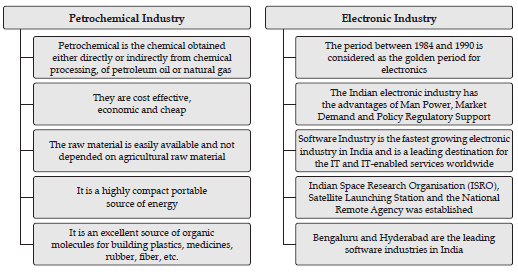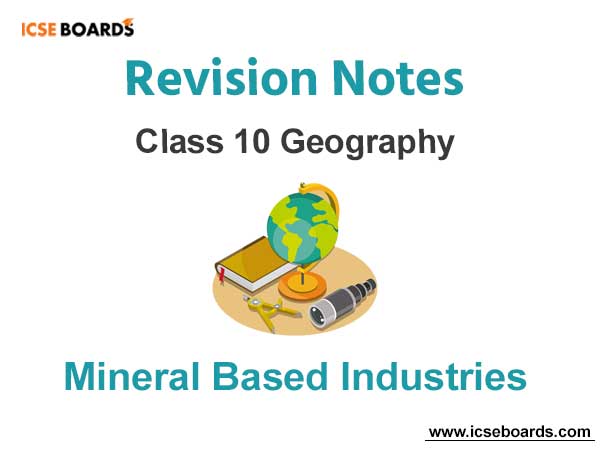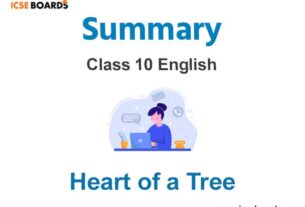Students should refer to Mineral Based Industries ICSE Class 10 Geography notes provided below designed based on the latest syllabus and examination pattern issued by ICSE. These revision notes are really useful and will help you to learn all the important and difficult topics. These notes will also be very useful if you use them to revise just before your Geography Exams. Refer to more ICSE Class 10 Geography Notes for better preparation.
ICSE Class 10 Geography Mineral Based Industries Revision Notes
Students can refer to the quick revision notes prepared for Chapter Mineral Based Industries in Class 10 ICSE. These notes will be really helpful for the students giving the Geography exam in ICSE Class 10. Our teachers have prepared these concept notes based on the latest ICSE syllabus and ICSE books issued for the current academic year. Please refer to Chapter wise notes for ICSE Class 10 Geography provided on our website.
Mineral Based Industries ICSE Class 10 Geography
Mineral Based Industries ICSE Class 10 Geography Notes
TOPIC-1
Iron and Steel Industries
Quick Review
➢ Iron and steel is the mother of all industries and forms the backbone of industrial development.
➢ It provides raw material to industries for manufacturing industrial machinery, railway engines, railway tracks, electrical machinery, defence equipments, bridges, dams, shops, automobiles, etc.
➢ India has one of the richest reserves of all the raw materials required for the industry, namely, capital, cheap labour, iron ore, power, coal, etc.
➢ Indi is the fifth largest crude steel producing country in the world.
➢ The main raw materials required for iron and steel is iron ore, manganese, limestone, silica, chromate, feldspar, scrap iron, flux and fuel.
➢ To make steel, impurities in the iron ore like, sulphur, silica, phosphorous, lime, etc. needs to be removed. It is done through the following process-
(a) During the iron making process, a blast furnace is fed with the iron ore, coke and small quantities of fluxes such as limestone.
(b) This slag floats on the molten iron and is collected at the base of the furnace at regular intervals.
(c) The product obtained is known as pig iron which can be converted into wrought iron, steel and cast iron.
(d) Through deoxidation the impurities are removed to convert pig iron into steel.
(e) The steel is cast into ingots and rolled into different sizes.
➢ Tata Iron and Steel Company (TISCO)
(i) TISCO is situated at Jamshedpur and is the oldest steel plant in the country.
(ii) It was established by Jamshedji Tata in 1907 and the production started in 1911.
(iii) The plant obtains its raw materials from the following places :
(a) Iron ore from Gurumahisani mines in Mayurbhanj district of Odisha and Noamundi mines in Singhbhum district of Jharkhand.
(b) Manganese from Joda in Keonjhar district.
(c) Limestone, dolomite and fire-clay from Sundargarh district of Odisha.
(d) Coal from the Jharia and Bokaro coalfields.
(iv) Kharkai and Subarnarekha are the two perennial rivers that supply water throughout the year.
(v) Labour is employed from the states of Bihar, West Bengal, Jharkhand, Chhattisgarh and Uttar Pradesh.
(vi) It has a good accessibility to market in Kolkata which is not only a market but also has facilities for export of finished goods.
(vii) Jamshedpur has a good network of roads and railways that are connected to other parts of the country.
(viii) TISCO produces high grade carbon steel, acid steel and special alloy steel. Carbon steel is used in structural fittings and tin plates and Acid steel is used for making railway wheels, axels, bars, rods, sheets, etc.
➢ Bhilai Iron and Steel
(i) Bhilai steel plant was established in 1953.
(ii) It is in collaboration with the erstwhile USSR.
(iii) It is located in Durg district of Chhattisgarh.
(iv) The plant obtains its raw materials from the following places-
(a) Iron Ore from Dalli Rajhara mines
(b) Limestone developed in Nandin inear Bhilai.
(c) Manganese obtained from neighbouring district of Balaghat.
(d) Coal is obtained from Bokaro, Kargati and Jharia fields in Jharkhand and Korba in Chhattisgarh.
(v) The main source of power is from the thermal station at Korba.
(vi) Water is supplied to the plant from a system of reservoirs at Tendula.
(vii) Bhilai steel plant has excellent transport facility as it lies on the Mumbai-Nagpur-Kolkata railway line which links to major markets.
(viii) A large number of labourers are employed from the states of Bihar, Jharkhand and Madhya Pradesh.
(ix) Bhilai plant produces heavy rails, structural beams, billets and rolled wire, plates for ship building industry.
(x) The plant also produces by-products like ammonium sulphate, benzol, coal tar and sulphate acid.
➢ Rourkela Steel Plant :
(i) This steel plant was established in 1959 with the technical collaboration from the German firm, Krupps and Demag.
(ii) It is located in the Sundargarh district of Odisha.
(iii) The plant obtains its raw materials from the following places-
(a) Iron ore from the reserves of Sundargarh and Keonjhar district of Odisha.
(b) Manganese is obtained from Barajmda.
(c) Limestone from Bhirmitrapur.
(d) Dolomite from Baradwar.
(e) Coal is obtained from Jharia, Talcher and Korba fields.
(f) Electricity is supplied from Hirakud Project.
(iv) Water is obtained from the Mandira dam across the Sankha river and Mahanadi river.
(v) Good transportation on the Kolkata-Nagpur rail line provides easy access to the raw material producing areas and to the markets.
(vi) Labourers are employed from the states of Bihar, West Bengal, Jharkhand and Odisha.
(vii) Rourkela Steel plant produces products like hot-rolled sheets, cold-rolled sheets, galvanized sheets and electrical steel plates.
(viii) It also produces large quantity of nitrogen which is used for the manufacture of fertilizers and various chemicals.
➢ Vishakhapatnam Steel Plant
(i) It is located at the port city of Vishakhapatnam in Andhra Pradesh.
(ii) It is the first shore based steel plant in India.
(iii) The plant obtains its raw materials from the following places-
(a) Iron ore is obtained from Bailadila in Chhattisgarh.
(b) Limestone, Dolomite and Manganese is obtained from the mines of Andhra Pradesh and Odisha.
(iv) It gets its power supply from the coalfields of the Damodar Valley.
(v) The plant produces liquid steel and saleable steel.
➢ Mini Steel Plants :
(i) Mini Steel plants are smaller units, work through electric furnaces and mainly uses steel scrap and sponge iron or pig iron as their raw material.
(ii) Mini steel plants are distributed throughout the country far away from the integrated steel plants.
(iii) Mini steel plants have the following advantages :
(a) Scarp iron is used as raw material which is cheap and easily accessible.
(b) These plants can be built with less capital investment.
(c) It does not cause pollution since it runs on electric power.
(d) These plants cater the needs of the local market and thus reduce the burden from the large steel plants.
(e) Their construction and gestation period is short.
➢ Problems of Iron and Steel Industry :
(i) Iron and Steel industry is a capital intensive industry.
(ii) The industry lacks behind in using advanced technological inputs.
(iii) The high grade coking coal used for smelting iron ore is limited.
(iv) Many small iron and steel plants have closed down due to inadequate supply of power and increasing cost of raw material
(v) The government has controlled and fixed the prices of the iron and steel which leaves for a marginal profit for the manufacturers.
(vi) Inefficient management and improper functioning of the iron and steel plants in the Public Sector.
(vii) Increasing demand of iron and steel results in the import of large quantities of iron and steel.
Know the terms
➢ Scrap Iron : The discarded or waste pieces of iron to be recast or reworked.
➢ Pig Iron : Crude iron that is the direct product of the blast furnace poured into moulds and is refined to produce steel, wrought iron or ingot iron.
➢ Ingots : It is a piece of pure material, usually metal, that is cast into a shape suitable for further processing.
➢ Galvanized Sheets : It is a sheet, strip or other steel item coated with a thin layer of zinc to prevent rusting.
➢ Mini Steel plants are smaller units, work through electric furnaces and mainly uses steel scrap and sponge iron or pig iron as their raw material.
➢ Integrated Steel Plants : A unified steel mill where all the primary functions of producing steel is carried out like iron making, steel making, casting, roughing rolling and product rolling.
Flowchart

TOPIC-2
Petrochemicals and Electronics
Quick Review
➢ Petrochemical Industry :
(i) Chemical obtained either directly or indirectly from chemical processing, of petroleum oil or natural gas is called Petrochemical.
(ii) India is amongst the fastest growing petrochemicals market in the world.
(iii) Major petrochemicals are acetylene, benzene, ethane, ethylene, methane, propane, and hydrogen, from which hundreds of other chemicals are derived.
(iv) Basically this industry is located near an oil refinery which can supply the basic requirements of Naptha or Ethylene and Benzene.
(v) These chemicals are used for manufacturing products like synthetic fibres, synthetic rubber, ferrous and non-ferrous metals, plastics, drugs and pharmaceuticals.
(vi) All these products are largely used in the domestic, industrial and agricultural fields.
(vii) The Petrochemical Industry produces the following products-
Adhesives, fertilizers, dyes, detergents, insecticides, pesticides, resins, crayon, plastic sheets, printing inks, paints, carbon paper, etc.
(viii) Advantages of Petrochemical Products-
(a) Petrochemicals are cost effective, economic and cheap.
(b) The raw material is easily available and not depended on agricultural raw material.
(c) It is a highly compact portable source of energy.
(d) It is an excellent source of organic molecules for building plastics, medicines, rubber, fiber, etc.
(ix) There are many Petrochemical Production Units in India. Some of them are as follows-
1. Herdillia Chemicals Ltd. in Chennai.
2. National Organic Chemicals Industries Ltd. near Mumbai.
3. Petrofils Cooperative Limited (PCL) in Vadodara.
4. Indian Petrochemical Corporation Ltd. near Vadodara.
5. The Reliance Industries in Gujarat.
6. Haldia Petrochemical Ltd. in West Bengal.
7. The Bongaigaon Petrochemicals Ltd. in Assam.
8. The Indian Oil Corporation in Gujarat and Panipat.
➢ Electronics-
(i) The Electronics Industry in India began around 1965 with an objective towards space and defence technologies.
(ii) India gradually developed in consumer electronics mainly with transistor radios, Black and White TV, Calculators and other audio products and later Colour Televisions were introduced.
(iii) The period between 1984 and 1990 is considered as the golden period for electronics during which the industry in India witnessed continuous and rapid growth.
(iv) India is also an exporter of a vast range of electronic components and products, e.g. display technologies, entertainment electronics, telecom equipment, Semiconductor designing, Electronic Manufacturing Services (EMS), etc.
(v) The Indian electronic industry has the following advantages which can effectively enhance its growth. They are Man Power (Skilled and Unskilled), Market Demand and Policy Regulatory Support.
(vi) India has been experiencing a strong growth in the demand of consumer products and durables in recent years which have facilitated the growth in the electronics sector both directly and indirectly.
(vii) The electronic industry in India is widely concentrated in the Southern States of India. Some of them are-
1. The Indian Telephone Industries (ITI) in Bengaluru.
2. The Electronics Corporation of India Ltd. (ECIL) in Hyderabad.
3. The Bharat Electronics Ltd. (BEL) in Bengaluru.
➢ (i) Space Technology in India was established in 1960s by the Department of Atomic Energy.
(ii) Indian Space Research Organisation (ISRO) at Bengaluru, Satellite Launching Station at Sriharikota and the National Remote Agency at Hyderabad was established which gave further impetus to space research programmes in India.
(iii) India made remarkable achievement by launching Aryabhata, India’s first master satellite which was aimed at growing advanced technology regarding the agricultural fields, weather forecasting etc.
(iv) Then Bhaskara-I was launched followed by the launching of Polar Satellite launching Vehicles popularly known as PSLV and Geosynchronous Satellite Launch Vehicle known as GSLV.
(v) In 2008, India’s first Scientific Mission, Chandrayaan-I, was launched to Moon.
(vi) India made further progress by launching its indigenously built satellites such as APPLE and INSAT series.
➢ (i) Software Industry is the fastest growing electronic industry in India.
(ii) The software industry is a leading destination for the IT and IT-enabled services worldwide.
(iii) The Department of Electronics has played an important role to enhance the competitiveness of India in IT.
(iv) The Department has initiated a number of programmes for manpower development, quality upgradation, stimulation of software engineering and research.
(v) The BPO (Business Process Outsourcing) industry is continuously growing.
(vi) Software giants, such as Infosys, Wipro, and TCS, are providing software solutions to clients overseas.
(vii) Bengaluru and Hyderabad are the leading software industries in India.
(viii) Bengaluru is referred to as the Silicon Valley of India and many MNCs, such as Capgemini and Yahoo, have forayed into the Indian market.
Know the terms
➢ Petrochemical : Chemical obtained either directly or indirectly from chemical processing, of petroleum oil or natural gas.
➢ Organic Molecules : These are usually composed of carbon atoms in rings or long chains, to which are attached other atoms of such elements as hydrogen, oxygen and nitrogen.
➢ Consumer Electronics : It is an electronic device or digital equipment which is used everyday by people.
➢ Regulatory Policy : It is about achieving government’s objectives through the use of regulations, laws and rules to deliver better economic and social outcomes.
➢ Space Technology : It is a technology developed by space science or the aerospace industry for use in spaceflight, satellites or space exploration.
➢ Chandrayaan-I : India’s first Scientific Mission, launched to Moon in 2008.
Flowchart


We hope you liked Mineral Based Industries ICSE Class 10 Geography notes above. If you have any questions please post them in the comments section below and our teachers will provide you a response.


